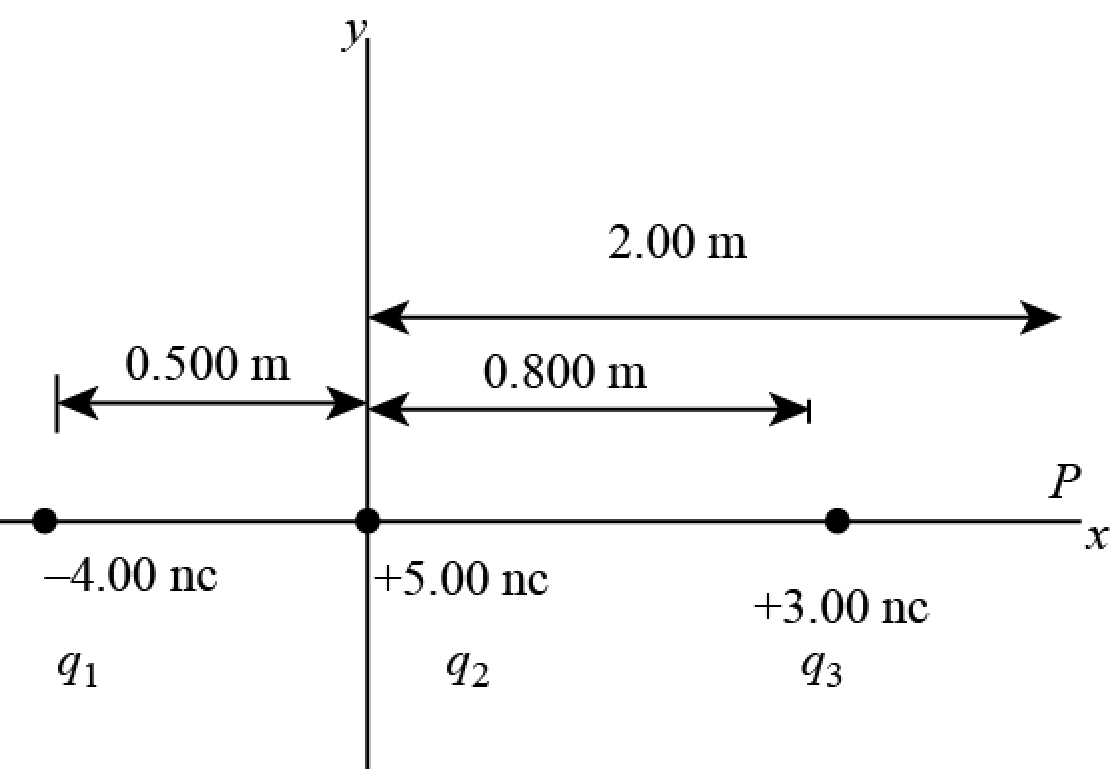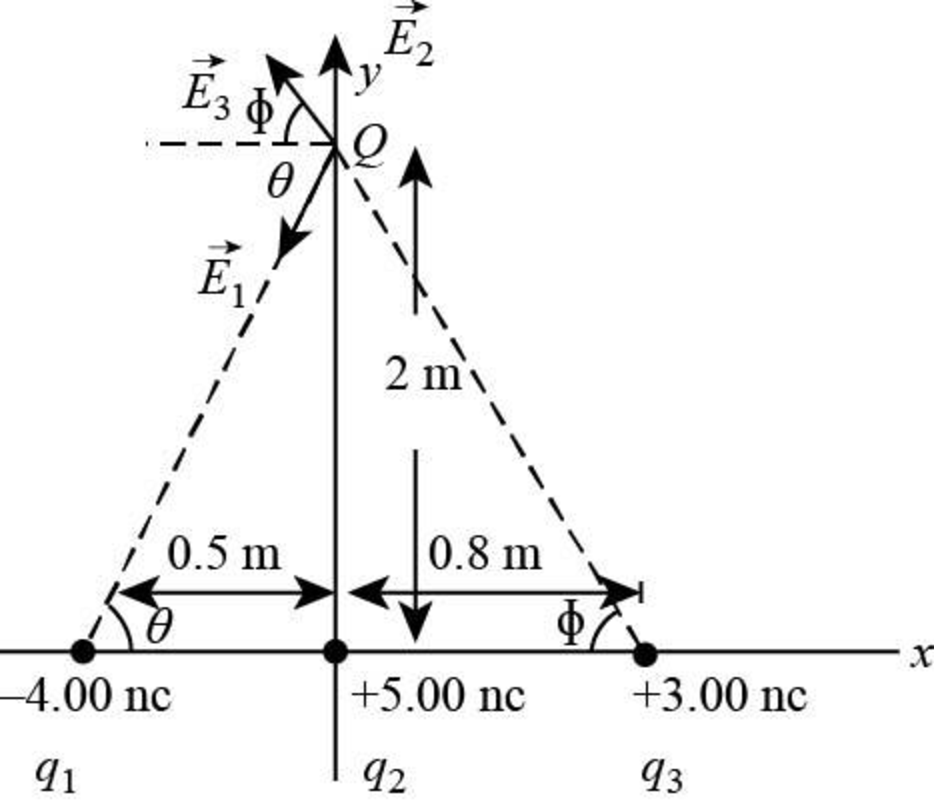
Concept explainers
Three charged particles are aligned along the x axis as shown in Figure P22.35. Find the electric field at (a) the position (2.00 m, 0) and (b) the position (0, 2.00 m).
Figure P22.35

(a)
The electric field at the position
Answer to Problem 35AP
The electric field at the position
Explanation of Solution
Three charges are acting on the same line along the
According to Coulomb’s law, write the expression for the electric field created by a charge
Here,
The electric field at a point due to number of charges is resultant of the electric field due to the individual charges.
The figure for the position of point charges is shown below.

Figure (1)
Write the expression for the electric field due to charge
Here,
Substitute
Write the expression for the electric field due to charge
Here,
Substitute
Write the expression for the electric field due to charge
Here,
Substitute
Write the expression for the resultant electric field
Here,
Conclusion:
Substitute
Thus, the electric field at position
(b)
The electric field at the position
Answer to Problem 35AP
The electric field at the position
Explanation of Solution
Three charges are acting on the same line along the
The figure for the position of point charges is shown below,

Figure (2)
According to Pythagoras theorem, the distance between the charge
Here,
According to Pythagoras theorem, the distance between the charge
Here,
Write the expression for the electric field due to charge
Here,
Substitute
In component form the electric field can be written as,
According to right angle triangle property,
And,
Substitute
Write the expression for the electric field due to charge
Here,
Substitute
Write the expression for the electric field due to charge
Here,
Substitute
In component form the electric field can be written as,
According to right angle triangle property,
And,
Substitute
Write the expression for the resultant electric field
Here,
Conclusion:
Substitute
Therefore, the electric field at position
Want to see more full solutions like this?
Chapter 22 Solutions
PHYSICS:F/SCI.+ENGRS.(LL)-W/SINGLE CARD
- Lab 8 Part 3 PHET Wave Interface simulation. I am having trouble with this part of the lab.arrow_forwardMick and Rick are twins born on Earth in the year 2175. Rick grows up to be an Earth-bound robotics technician while Mick becomes an intergalactic astronaut. Mick leaves the Earth on his first space mission in the year 2200 and travels, according to his clock, for 10 years at a speed of 0.75c. Unfortunately, at this point in his journey, the structure of his ship undergoes mechanical breakdown and the ship explodes. How old is Rick when his brother dies?arrow_forwardHi, I have canceled, why did you charge me again?arrow_forward
 Physics for Scientists and EngineersPhysicsISBN:9781337553278Author:Raymond A. Serway, John W. JewettPublisher:Cengage Learning
Physics for Scientists and EngineersPhysicsISBN:9781337553278Author:Raymond A. Serway, John W. JewettPublisher:Cengage Learning Physics for Scientists and Engineers with Modern ...PhysicsISBN:9781337553292Author:Raymond A. Serway, John W. JewettPublisher:Cengage Learning
Physics for Scientists and Engineers with Modern ...PhysicsISBN:9781337553292Author:Raymond A. Serway, John W. JewettPublisher:Cengage Learning Physics for Scientists and Engineers: Foundations...PhysicsISBN:9781133939146Author:Katz, Debora M.Publisher:Cengage Learning
Physics for Scientists and Engineers: Foundations...PhysicsISBN:9781133939146Author:Katz, Debora M.Publisher:Cengage Learning Principles of Physics: A Calculus-Based TextPhysicsISBN:9781133104261Author:Raymond A. Serway, John W. JewettPublisher:Cengage Learning
Principles of Physics: A Calculus-Based TextPhysicsISBN:9781133104261Author:Raymond A. Serway, John W. JewettPublisher:Cengage Learning College PhysicsPhysicsISBN:9781285737027Author:Raymond A. Serway, Chris VuillePublisher:Cengage Learning
College PhysicsPhysicsISBN:9781285737027Author:Raymond A. Serway, Chris VuillePublisher:Cengage Learning College PhysicsPhysicsISBN:9781305952300Author:Raymond A. Serway, Chris VuillePublisher:Cengage Learning
College PhysicsPhysicsISBN:9781305952300Author:Raymond A. Serway, Chris VuillePublisher:Cengage Learning





